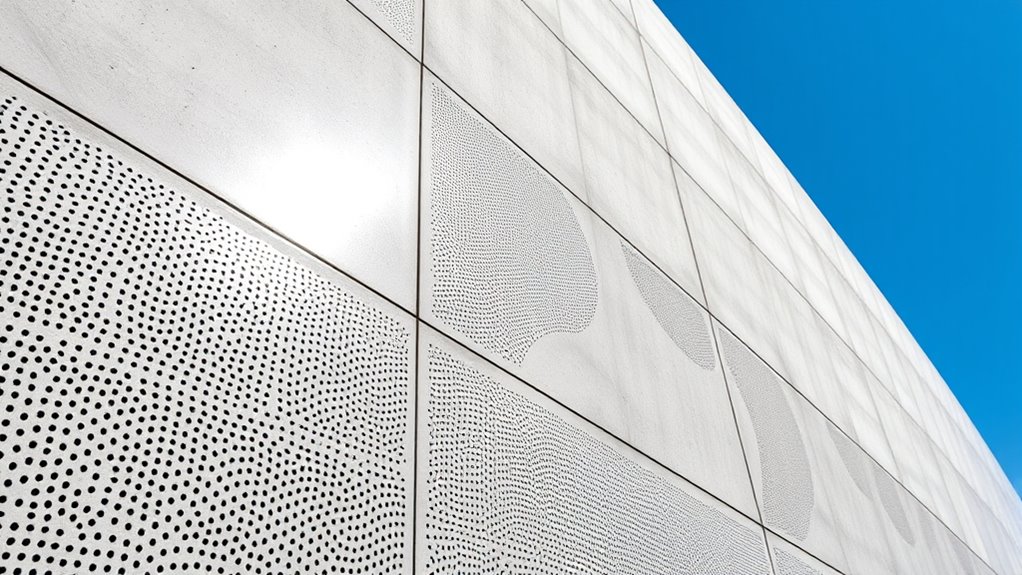Carbon-eating concrete absorbs and permanently traps CO₂ during production, turning a major greenhouse gas source into a sustainable building material. It reacts with minerals in the concrete to form stable calcium carbonate, which enhances strength and durability while reducing emissions. This innovative material can sequester up to 45% of CO₂ without sacrificing performance. If you want to discover how this technology could transform the construction industry and help the environment, keep exploring.
Key Takeaways
- Carbon-eating concrete captures CO₂ during production, converting it into stable calcium carbonate within the material.
- It reduces greenhouse gas emissions by utilizing industrial CO₂ emissions, acting as a permanent carbon sink.
- The mineral carbonation process enhances concrete strength, durability, and microstructure.
- This innovative concrete can sequester up to 45% of CO₂ without compromising structural performance.
- It offers a sustainable solution for the construction industry to help lower its carbon footprint and clean the air.

Have you wondered how concrete can help fight climate change? The answer lies in a revolutionary approach called carbon-eating concrete, which actively captures and permanently traps CO₂ during production. Instead of just serving as a sturdy building material, this concrete works as a carbon sink, reducing greenhouse gases in the atmosphere. It uses captured CO₂ from industrial emissions, such as flue gases at cement plants, and incorporates it into the concrete through a process called mineral carbonation. This chemical reaction converts CO₂ into calcium carbonate—a stable compound that becomes an integral part of the concrete microstructure. The result is concrete that not only traps CO₂ permanently but also exhibits enhanced density, strength, and durability compared to traditional mixes.
Concrete that captures and permanently locks away CO₂ to build a sustainable future.
As you might imagine, this process involves CO₂ reacting with alkaline earth metals like calcium and magnesium present in the concrete. The mineralization is thermodynamically favorable, meaning it occurs naturally with low energy input, making it an efficient method for carbon sequestration. The solid carbonates formed are stable, so once embedded, the CO₂ is effectively locked away, preventing any re-release into the atmosphere. This process is compatible with various CO₂ sources, including captured industrial emissions and direct air capture systems, making it flexible and scalable. Waste streams from different industries can even be valorized by incorporating them into the concrete, turning waste into a useful resource. Additionally, ongoing research aims to optimize the reaction conditions to further improve sequestration capacity and efficiency.
Furthermore, mineral carbonation improves the concrete’s microstructure, increasing its density and overall performance. This means stronger and more durable concrete that requires less cement, which is significant because cement production accounts for about 8% of global greenhouse gas emissions. Lab tests have shown that during manufacturing, the process can sequester up to 45% of CO₂ without sacrificing strength, allowing the concrete to meet standard construction requirements like beams, slabs, and columns. The key advantage is that this process can be integrated into existing production lines without major modifications, making adoption easier for manufacturers. Research advances indicate ongoing efforts to optimize reaction conditions and enhance sequestration capacity further.
Numerous companies and research groups worldwide are commercializing these innovations. For example, CarbonCure injects CO₂ directly into concrete mixers, permanently mineralizing the gas within the material. Finnish companies are developing carbon-negative concrete blocks, and some projects combine direct air capture with concrete production to sequester atmospheric CO₂. By embedding captured CO₂ into building materials, carbon-eating concrete not only reduces the carbon footprint of construction but also contributes to global efforts toward carbon neutrality. It’s a promising technology that turns the concrete industry’s environmental challenge into an opportunity to clean the air and build a more sustainable future.
Frequently Asked Questions
How Long Does the Air Purification Effect Last?
You might wonder how long the air purification effect lasts. It depends on factors like concrete porosity, moisture, and environmental exposure. Generally, carbonation and CO2 sequestration can continue for decades, with some structures absorbing carbon for over a century. Proper maintenance and consistent air contact are essential. With ideal conditions, your concrete could keep cleaning the air for many years, making it a long-term, effective method of reducing carbon in the atmosphere.
Can the Concrete Be Recycled or Reused?
You can definitely recycle or reuse concrete, especially with emerging technologies. Using methods like cement recycling via arc furnace technology, you reduce emissions and create recycled cement for new concrete. Incorporating waste materials like wood or recycled aggregates also enhances sustainability. Additionally, carbon sequestration techniques, such as injecting CO₂, allow recycled concrete to store carbon. While some processes need refinement, these innovations make concrete reuse more practical and environmentally friendly.
What Are the Potential Environmental Impacts of Production?
You might think concrete production is sustainable, but it has significant environmental impacts. You’ll find that cement manufacturing accounts for about 8% of global CO2 emissions, releasing nearly a tonne of CO2 per tonne of cement. It requires enormous energy, consumes vast water resources, and contributes to resource depletion. While concrete can absorb some CO2 over time, the initial emissions and resource use pose serious environmental challenges that need addressing.
How Does It Compare Cost-Wise to Traditional Concrete?
You’ll find that low-carbon concrete generally costs 40% to 140% more upfront than traditional concrete, mainly due to the use of alternative materials and supply chain adjustments. However, some regions report only a small premium, around $2–$20 per cubic yard. While initial costs are higher, long-term savings from durability and lower maintenance can offset the expense, especially as supply chains improve and economies of scale develop.
Are There Any Health Risks Associated With Its Use?
You might wonder if using carbon-eating concrete poses health risks. It’s important to know that concrete production emits about 0.93 pounds of CO2 per pound of concrete, exposing workers to elevated CO2 levels that can cause respiratory issues. Handling raw materials like fly ash may also release toxic or radioactive substances. Proper safety protocols, protective gear, and containment reduce these risks, making it safer for workers and the environment.
Conclusion
Just like a mighty tree absorbs carbon, this concrete becomes a silent guardian of our planet, transforming from mere construction into a hero that fights pollution. You hold the power to choose such innovations, turning gray cities into breathing landscapes. Embrace these advancements, and imagine yourself planting seeds of change—building a future where even concrete can heal the Earth, one breath at a time. Together, you can pave the way for a cleaner, greener world.










